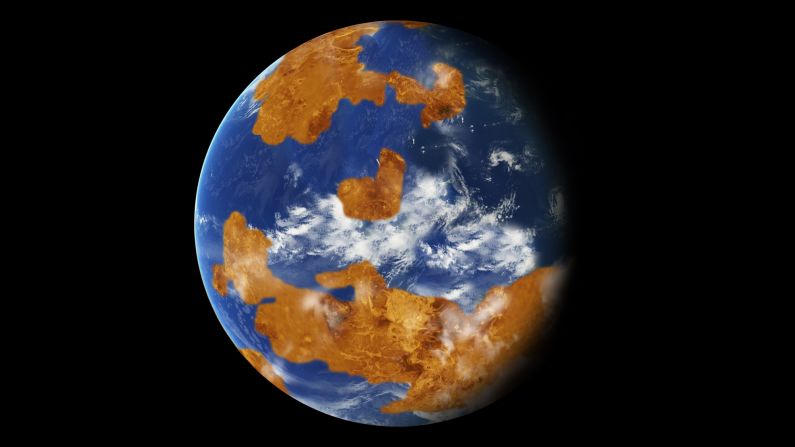
Research suggests Venus may have had water oceans billions of years ago. A land-ocean pattern was used in a climate model to show how storm clouds could have shielded ancient Venus from strong sunlight and made the planet habitable.

Jupiter's moon Europa, which has a subsurface ocean beneath an icy crust, has also been found to contain table salt. Tara Regio is the yellowish area to left of center where researchers identified an abundance of sodium chloride.

Europa has also been found to have plumes that eject water vapor and icy material.

An artistic impression of the Mars Express spacecraft probing the southern hemisphere of Mars. Radar detected a lake of liquid water beneath the surface.

Two meteorites, called Monahans and Zag, are the first discovered to contain the ingredients for life: liquid water, amino acids, hydrocarbons and other organic matter. The organic matter was found in purple and blue salt and potassium crystals that were part of the meteorites.

NASA's Cassini mission has evidence of an ocean inside Saturn's largest moon, Titan, which might be as salty as the Earth's Dead Sea.

NASA is exploring the ocean worlds in our solar system as part of the search for life outside of Earth.

Life as we know it is carbon-based and requires liquid water. About 70% of the Earth's surface is covered with water, making life possible.

The Eagle lunar module of Apollo 11 ascends from the surface of Earth's moon in 1969. The presence of water on the moon has been confirmed by scientists.

Mercury is the closest planet to the sun and very hot, but its polar regions may have water ice and other frozen volatile materials, according to NASA studies.

Water still flows across the surface of Mars from time to time, NASA scientists said in 2015. In the photo above, dark, narrow streaks called recurring slope lineae are seen flowing downhill on Mars. Scientists have inferred that they were formed by contemporary flowing water.

Dwarf planet Ceres, composed of rock and ice, is the largest object in the asteroid belt.

In this artist's concept, the moon Ganymede, right, orbits the giant planet Jupiter. NASA's Hubble Space Telescope observed auroras on the moon generated by Ganymede's magnetic fields. A saline ocean under the moon's icy crust best explains shifting in the auroral belts measured by Hubble.

The trailing hemisphere (the side that faces away from its direction of motion) of Jupiter's moon Europa was captured by the Galileo spacecraft. The left image shows Europa in approximately true color and the right image shows Europa in enhanced color to bring out details. NASA data suggest that Europa has a subsurface ocean.

Voyager 1 captured this image of Jupiter's moon Callisto. Scientists have detected ice and carbon dioxide on its surface.

Gravity measurements by NASA's Cassini spacecraft and Deep Space Network indicate that Saturn's moon Enceladus, which has jets of water vapor and ice gushing from its south pole, also harbors a large interior ocean beneath an ice shell, as this illustration depicts.

Mimas, the smallest and closest of Saturn's eight main moons, is heavily cratered and has a low density that suggests it is mostly composed of water ice. The moon's main 88-mile-long crater makes it resemble "Death Star" from "Star Wars Episode IV."

Neptune's largest moon, Triton, is so cold that its surface is composed mainly of nitrogen ice.

An artist's concept shows Pluto and its moons. Pluto's moon Charon has cracks that suggest it once had underground water.